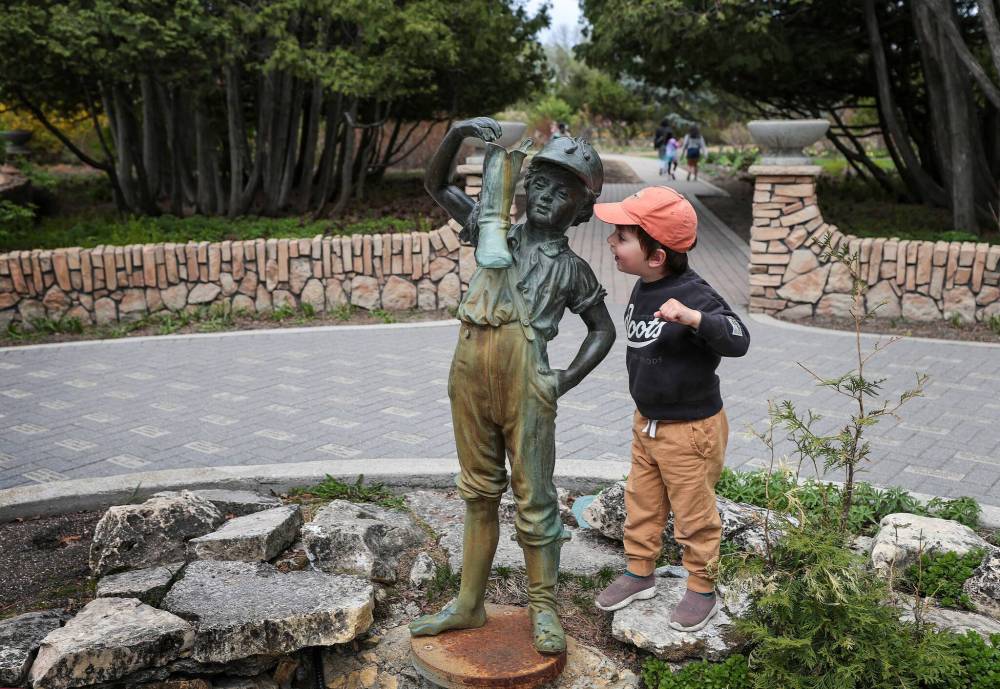Heritage designations could soon protect a well-known statue, honour a significant peacemaker and keep some greenspace intact.
The Boy With the Boot statue is among several pieces of property nominated for addition to the city’s list of historical resources. If council approves the change, it would be protected against demolition.
The 140-kilogram, 1.2-metre tall bronze statue depicts a small boy holding a leaking boot and served as one of Winnipeg’s earliest public fountains.

Ruth Bonneville / Free Press
Jackson Grusko, age three, gets a closer look at the Boy with the Boot statue at the entrance to the Assiniboine Park’s English Garden Monday. The statue is one of several structures that are being considered for heritage status.
A city report notes the statue was first erected in 1898 at a former city hall building but moved to Assiniboine Park by 1913, where it now stands in the English Garden.
“Heritage resides in lots of places and I don’t think we should think that only buildings are appropriate for recognition. In this case, generations of Winnipeggers will be familiar with the Boy With the Boot. He has stood in Winnipeg for almost 130 years. It’s a cherished thing,” said Gordon Goldsborough, head researcher for the Manitoba Historical Society.
While the city still mostly nominates buildings for heritage designations, it expanded to consider other property years ago, Goldsborough noted.
“Just as buildings can remind us of past conditions … it’s the same thing with statues … Sometimes those are the good things, such as the Boy With the Boot. He’s very whimsical, people love to see him,” he said.
The statue hasn’t been significantly altered over time despite facing unique risks, a city report notes.
“The statue appears to be in good condition despite numerous incidents of theft and vandalism. Several times, park officials have found the statue with the boot missing and, in 1994, a local fraternity stole the entire statue. After several months, it reappeared in (a barn at the home of) popular local radio host (Peter Warren) with a note that read, ‘Timmy went on a journey, Timmy is lonely and wants to go home.’ The parks department repaired and reinstalled the statue,” the report notes.
The statue celebrates both the British monarchy and is a highlight of one of Winnipeg’s best-known parks, according to the report. It was paired with a bust of Queen Victoria on a tall pillar when it was originally unveiled.
The city report notes the meaning behind the statue isn’t clear, though there are similar ones in the United States, Europe and Cuba. The Boy With the Boot is the only statue of its kind identified in Canada.
“Its construction history is unclear and the origin of the reason for its creation range from remembering a drowned Italian newspaper seller, to a Civil War drummer-boy who carried water to his fallen comrades, to a young firefighter who used his boot in a bucket chain or emptied it after the fire was out,” the report said.
Murray Peterson, the city’s heritage officer, said the Boy with the Boot would be only the second statue the city adds to its list of historical resources, pending council approval.
“It hearkens back to sort of really early Winnipeg history … We don’t usually deal with 19th century (property), so that would make it rarer than most,” said Peterson.
The Belgian War Memorial statue on Provencher Boulevard was previously added to the heritage list.
Meanwhile, the committee will also consider granting the same heritage protection to Peguis Pavilion at Kildonan Park, to preserve its two-storey structure, park setting and landscaping, patio spaces, retaining walls, windows, open decks, ceiling and more.
A city report states the 1965 building has both historical and architectural significance.
“The Peguis Pavilion remembers a great Indigenous leader of the area now known as Winnipeg during the early years of colonial contact and has been an integral part of Kildonan Park for many decades,” it states.
Coun. Sherri Rollins, chairwoman of the property and development committee, said the site reflects a rich cultural history.
“Peguis is just this leader and a peacemaker in a way that is unique … to this territory. There’s not enough things, in my opinion, named for Chief Peguis,” said Rollins (Fort Rouge-East Fort Garry).
The councillor said the nomination of the park setting around the building will also align with a city priority to preserve key greenspaces.
“This is really exciting and really in line with (Winnipeggers’) values … Green spaces and landscaping are of equal historical relevance to buildings themselves,” said Rollins.
Peterson said the pavilion is a “spectacular” building made at the height of Winnipeg modern architecture.
“There were just exceptional artists, just some of the best designers Canada has ever produced,” he said.
Peterson said the landscape, exterior and interior of the building were all designed to complement each other.
The city’s historical buildings and resources committee will consider the historic designations of the city-owned property on Friday. Any addition to the historical resources list would require full city council approval.
joyanne.pursaga@freepress.mb.ca
X: @joyanne_pursaga

Joyanne Pursaga
Reporter
Born and raised in Winnipeg, Joyanne loves to tell the stories of this city, especially when politics is involved. Joyanne became the city hall reporter for the Winnipeg Free Press in early 2020.